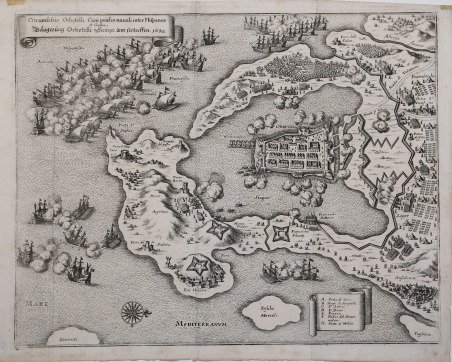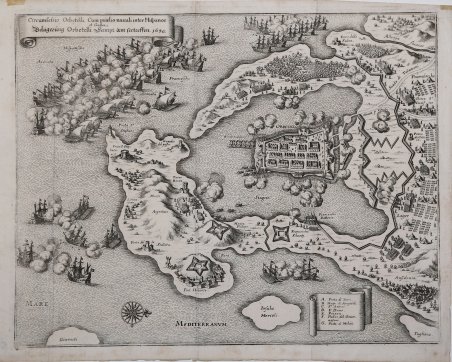Veduta obliqua dall'alto della città-fortezza di Orbetello, in mano agli spagnoli, assediata tra il 12 maggio e il 24 luglio dai francesi, comandati da Tommaso Francesco di Savoia, principe di Carignano (21 dicembre 1596-22 gennaio 1656), che alla fine furono costretti a togliere l'assedio dopo l'arrivo di un esercito di soccorso spagnolo comandato da Gerolamo Maria Caracciolo, marchese di Torrecuso, e Rodrigo Ponce de León, IV duca d'Arcos. L'opera viene realizzata in occasione del celebre assedio alla città del 1646. La città, parte dello Stato dei Presidi, era sotto la dominazione spagnola. Tra il 12 maggio ed il 24 luglio 1646 Orbetello subì un assedio da parte dell'esercito francese, che venne respinto. Tavola pubblicata nell'opera "Newe Archontologia Cosmica" di Johann Philip Zabelin, meglio conosciuto con lo pseudonimo di J.L. Gottfried, arricchita dalle tavole di Mattheus Merian.Il "Neuwe Archontologia cosmica, Das ist Beschreibung aller Kayserthumben Königreichen und Republiken der gantzen Welt ' [.]", viene edito a Francoforte nel 1638 e ristampato in lingua latina nel 1638 e nel 1649 e in lingua tedesca nel 1646 e nel 1695.La stampe di Merian sembrano essere anche stata pubblicata separatamente, e confluirono nel “Theatrum Europaeum” una sorta di giornale sulla storia delle terra, in lingua tedesca, iniziato da Matthäus Merian e proseguito poi da altre editori, che venne pubblicato tra il 1633 e il 1738 [in 21 volumi in quarto]. Matthäus Merian il vecchio (1593-1650) incisore svizzero nativo di Basilea, lavorò a Francoforte dove ebbe modo di lavorare nella bottega fondata da Theodor de Bry. Merian si segnalò, tanto da sposare Maria Magdalena de Bry, figlia di Johann Theodore de Bry, e dal 1625 circa da prendere in mano l'azienda, dandole un notevole incremento ed occupandosi in particolare dello sviluppo dei libri di topografia e di viaggi. Nella tipografia Merian lavorarono anche i figli Kaspar e soprattutto il quotato Matthaeus il giovane, i quali dopo la morte del padre proseguirono con immutato successo la gestione dell'attività che continuò fino al 1727. Nel 1638 Merian stampò la Neuwe Archontologia cosmica, das ist, Beschreibung aller Kaÿserthumben, Königreichen und Republicken der gantzen Welt opera sulla descrizione del Mondo già uscita dieci anni prima con una veste modesta che Merian rivoluzionò arricchendola con 98 tavole alcune delle quali a doppio foglio. L'Archontologia conobbe altre quattro edizioni fino al 1695 con testo o in latino o in tedesco, non omogenee per numero e tipologia di incisioni inserite. Nel 1640 venne pubblicato Itinerarium Italiæ Nov-antiquæ scritto da Martin Zeiller, ristampato nel 1688 col titolo Topographiæ Italiæ. Incisione in rame, in ottimo stato di conservazione. A high oblique view of the Spanish-held fortress town of Orbetello, besieged between 12 May and 24 July by the French, commanded by Thomas Francis of Savoy, Prince of Carignano (21 December 1596-22 January 1656), who were eventually obliged to lift the siege after the arrival of a Spanish relief army commanded by Gerolamo Maria Caracciolo, Marqués de Torrecuso, and Rodrigo Ponce de León, 4th Duke of Arcos. Franco-Spanish War (1635-1659). Oriented with west [actually, north-west] to top (compass directions written at the edges of the print). Devoid of a date, the work was created on the occasion of the famous siege of the city in 1646. The town, part of the Stato dei Presidi, was under Spanish rule. Between May 12 and July 24, 1646 Orbetello suffered a siege by the French army, which was repulsed. It is therefore one of the so-called broadsheets or works that were created to document an event, usually war, and that publishers rushed to print to satisfy popular curiosity. This plate was first used in Johann Ludwig Gottfried, "Neuwe Archontologia Cosmica.", first published by Matthias Merian in 1638, and reissued in numerous later editions. The print seems also to have been published separately.Then it was included in the “Theatrum Europaeum”; was a journal on the history of the German-speaking lands by Matthäus Merian, published between 1633 and 1738 in 21 quarto volumes. Matthäus Merian the Elder (1593-1650) Swiss engraver native of Basel, worked in Frankfurt where he was able to work in the workshop founded by Theodor de Bry. Merian distinguished himself, so much so that he married Maria Magdalena de Bry, daughter of Johann Theodore de Bry, and from about 1625 he took over the company, giving it a considerable increase and dealing in particular with the development of topography and travel books. The Kaspar sons and above all the renowned Matthaeus the younger also worked in the Merian typography, who after the death of their father continued with unchanged success the management of the business which continued until 1727. In 1638 Merian printed the Neuwe Archontologia cosmica, das ist, Beschreibung aller Kaÿserthumben, Königreichen und Republicken der gantzen Welt works on the description of the World already published ten years earlier with a modest look that Merian revolutionized by enriching it with 98 tables, some of which are double sheets. The Archontologia went through four other editions up to 1695 with text either in Latin or in German, not homogeneous in terms of the number and type of engravings inserted. In 1640 Itinerarium Italiæ Nov-antiquæ written by Martin Zeiller was published, reprinted in 1688 with the title Topographiæ Italiæ. Copperplate, in good condition. Cfr.


Scopri come utilizzare
Scopri come utilizzare

